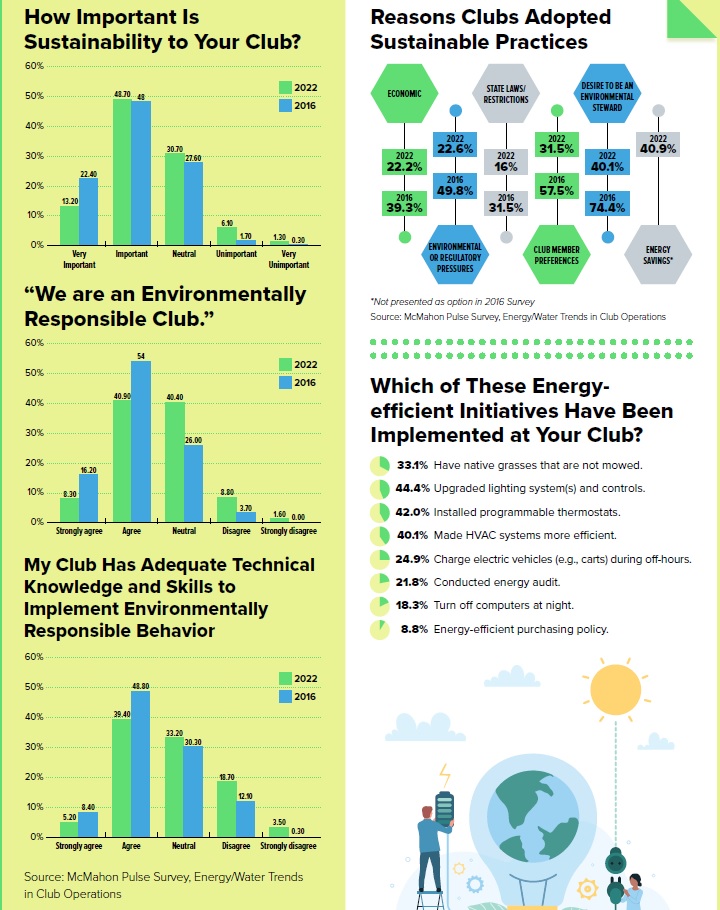Last October, a Pulse Survey was sent to McMahon Group’s database of clubs to gauge current levels of attention being paid to energy efficiency, water conservation and other sustainable practices in club operations. The results, when compared to those from a similar survey conducted in 2016, showed a noticeable lessening of attention to sustainable practices in club operations:
Less than half (49.2%) of the respondents in 2022 showed some level of agreement with the statement, “We are an environmentally responsible club,” compared with almost two-thirds (66.2%) of those responding in 2016.
Only 58.9% of the clubs surveyed in 2022 reported that their club employs sustainable practices, compared to 73.7% of respondents to the 2016 survey.
Only 13.2% of those surveyed in 2022 said that sustainability is “very important” for their club, compared to 22.4% in 2016.
Only 13.2% of those surveyed in 2022 said that sustainability is “very important” for their club, compared to 22.4% in 2016.
Another 6.4% of those surveyed in 2022 said sustainability is either unimportant or very unimportant, compared to 3% in 2016.
Only 38.3% of the respondents in 2022 indicated that their clubs plan to implement sustainable practices, compared to 59% in 2016.
The Reasons
These dropoffs are most likely explained by the developments that have com- manded clubs’ primary attention in the six years between surveys—most notably, operating challenges brought about by the pandemic, followed by a surge in membership and use after clubs pivoted so successfully to position themselves as especially safe and appealing options for social and recreational activities.
But those expanded memberships, along with increased waitlist demand, have put a renewed focus on whether club facilities will be able to stand up to what promises to be extended and more intensive use for many years to come. In turn, this has escalated clubs’ long-range strategic planning efforts and revived, or in some cases started, the development of facility master plans to prepare for properly meeting all of the added demand that’s projected.
As described in “Getting Club Facilities Under Control,” (p. 9) this also promises to swing the pendulum back toward addressing sustainability issues, particularly for clubs with historic clubhouses and properties that will discover just how inefficiently many of their current facilities are as they look to replace or upgrade them.
A hint that this is already beginning to happen came from the results of the question in the 2022 Pulse Survey that asked clubs to cite their reasons for now adopting sustainable practices. Energy savings was cited as the most compelling reason:

As the focus on energy savings increases, we can expect to see greater interest in, and application of, technology-based solutions to improve the efficiency and “footprints” of club facilities, such as solar power, geothermal heating/cooling, LED lighting, “smart” or programmable controls, HVAC upgrades and other initiatives. (The 2022 Pulse Survey showed there still has not been widespread application of any of this technology within clubs to date, and that many clubs cited a lack of technical knowledge as a factor behind its lagging adaptation.) While the primary driver of these improvements will be cost savings, a secondary benefit will be helping to revive clubs’ interest in being viewed, by their current and prospective memberships as well as the public at large, as good stewards of the land, its environs, and its inhabitants.



